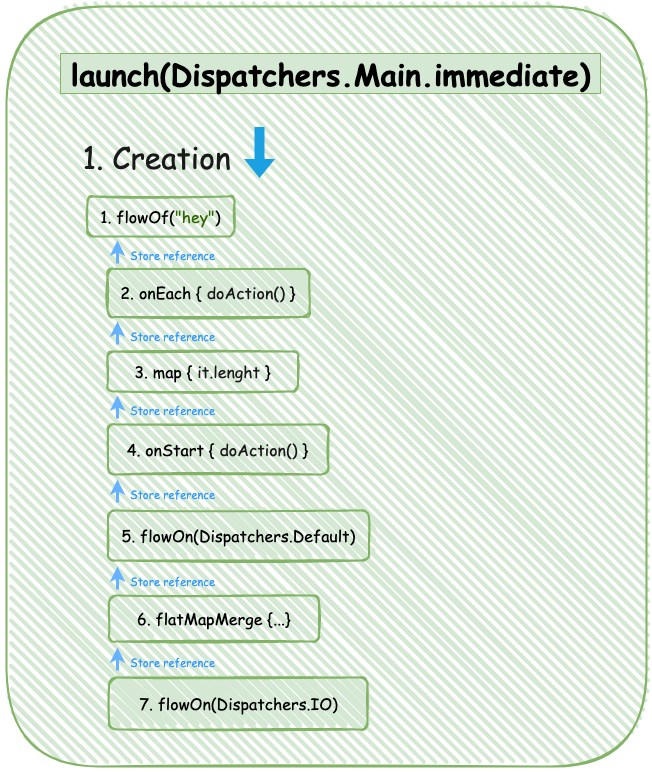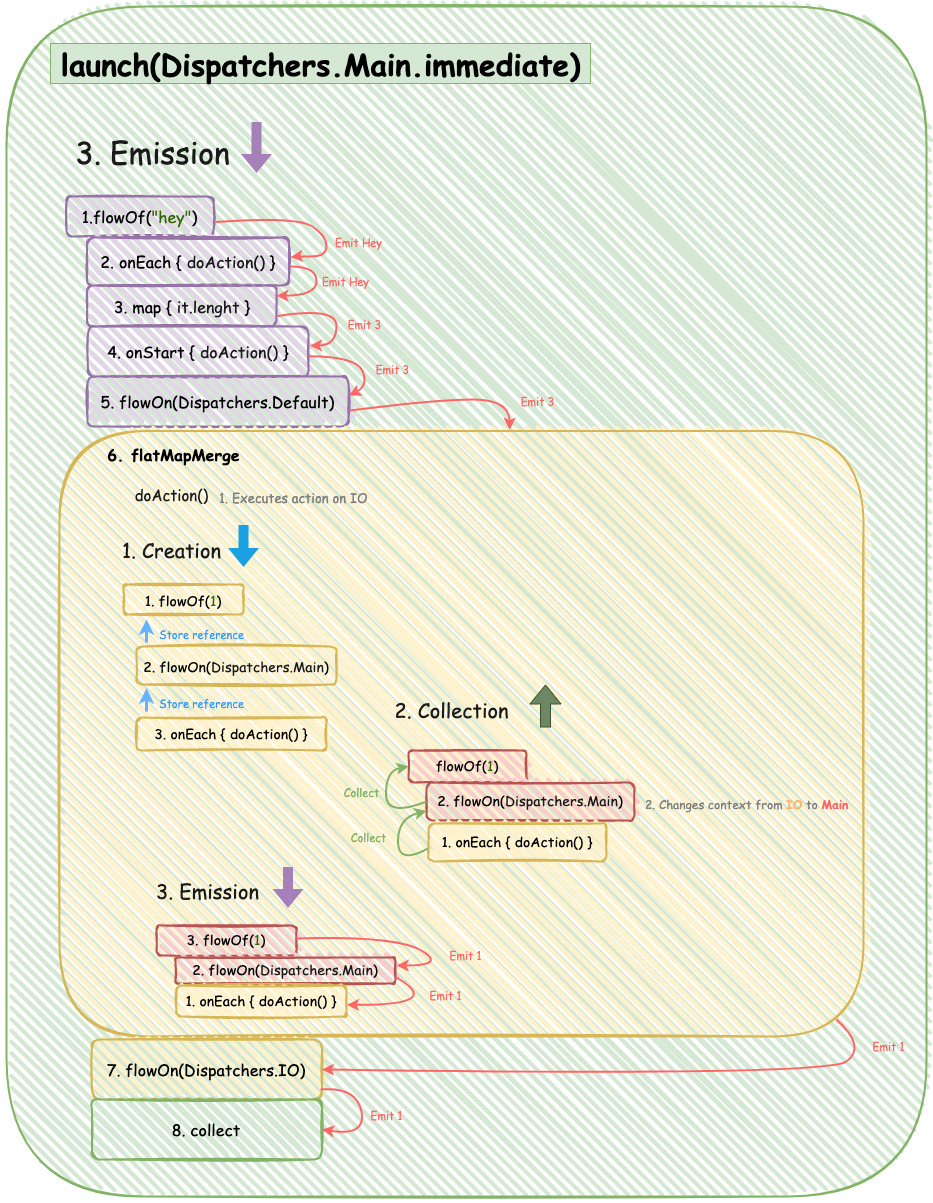In my previous post, I described how RxJava actually works. For a long time, it has been a non-official standard and the main tool for working with streams and multithreading in Android. But now we have an alternative from Jetbrains, recommended by Google — Coroutines.
Despite the fact that Coroutines have been rising a lot of questions among developers, nowadays almost every new project no longer contains a dependency on RxJava. And Flow played a significant role in this.
What this post is about
In this post, I will tell you how Flow works. You will learn about the basic principle and its lifecycle, as well as about dispatching.
This post is addressed both to those who take their first steps trying to understandFlow, and those who have years of practice.
The chain
| CoroutineScope(context = Dispatchers.Main.immediate).launch() { | |
| doAction() | |
| flowOf("Hey") | |
| .onEach { doAction() } | |
| .map { it.length } | |
| .onStart { doAction() } | |
| .flowOn(Dispatchers.Default) | |
| .flatMapMerge { | |
| doAction() | |
| flowOf(1) | |
| .flowOn(Dispatchers.Main) | |
| .onEach { doAction() } | |
| } | |
| .flowOn(Dispatchers.IO) | |
| .collect { | |
| doAction() | |
| } | |
| } | |
| } |
Our goal is to determine in which sequence and on which thread each action will be performed.
Basics and lifecycle
Flow is built on just two interfaces:
| public interface Flow<out T> { | |
| public suspend fun collect(collector: FlowCollector<T>) | |
| } | |
| public fun interface FlowCollector<in T> { | |
| public suspend fun emit(value: T) | |
| } |
Together, they form the basis for the Consumer & Producer pattern implementation.
Before going further, I highly recommend you to take a look at an example of writing a stream API, based on the two interfaces.
Each Flow chain consists of a specific set of operators. Each operator creates a new Flow instance but at the same time stores a reference to another Flowinstance that is located above. Operators do not start until the collect method is called. (Cold operators).
The lifecycle is presented by five important stages:
- Launching ️️⬇️
A coroutine launches on the Dispatcher we transmitted to CoroutineScope.
After that, the following steps take place: Flow Creation, Operators Collection & Data Emission. The final result will be processed on the transmitted Dispatcher. - Flow creation ⬇️
Operators are created from top to bottom on the current execution thread. (Similar to the Builder pattern.) - Operators collection ⬆️
Performed from the bottom up. Each operator collects the upper one - Data emission ⬇️
Starts when all operators have successfully called collect at the top stream. Goes from the top down. - Cancellation/Completion. The entire chain dies 😵
Execution cancelled/Completed
Let’s take a closer look at each of the stages.
Launching
| val job = CoroutineScope(Dispatchers.Main.immediate).launch { | |
| doAction() | |
| /*.../* | |
| } |
Scope launching
Everything seems clear at the first glance. We create a scope that runs a coroutine on the Main thread. The doAction() method is also launched on this coroutine.
Scope returns Job which we can use to manage the lifecycle. (For example, we can stop all the work by executing the cancel() method.)
Role of immediate dispatcher
In Android, the only way to switch the thread to Main is to use the Handler/Looper/MessageQueue chain.
This logic hides behind HandlerContext, which hides behind Dispatchers.Main
| //handler here is created with Looper.mainLooper() | |
| override fun dispatch(context: CoroutineContext, block: Runnable) { | |
| if (!handler.post(block)) { | |
| cancelOnRejection(context, block) | |
| } | |
| } |
Now suppose that we are already on the Main thread, but we are still switching to the Main thread using handler.post
In this case, our code will not be executed immediately, which may affect the user experience, for example, cause the screen to blink.
The code will have to go through the entire chain through MessageQueue that can be busy processing other commands. The main idea of Dispatchers.Main.immediate is to skip this queue and execute the code immediately.
Dispatcher has an isDispatchNeeded method that helps us out in such a case. In HandlerContext, this method is implemented as follows:
| override fun isDispatchNeeded(context: CoroutineContext): Boolean { | |
| return !invokeImmediately || Looper.myLooper() != handler.looper | |
| } |
Dispatchers.Main.immediate creates a new instance at HandlerContext, which switches invokeImmediately to true. As a result, the Looper of the Main thread will always be compared with the Looper of the current thread, thus preventing an extra call to handler.post.
Flow creation
The starting point of our chain is flowOf(“hey”).
Under the hood, we can see that we explicitly create a new instance of Flow and store the value in a lambda, which will be called at the collection stage:
| import kotlinx.coroutines.flow.internal.unsafeFlow as flow | |
| public fun <T> flowOf(value: T): Flow<T> = flow { | |
| emit(value) | |
| } | |
| internal inline fun <T> unsafeFlow(crossinline block: suspend FlowCollector<T>.() -> Unit): Flow<T> { | |
| return object : Flow<T> { | |
| override suspend fun collect(collector: FlowCollector<T>) { | |
| collector.block() | |
| } | |
| } | |
| } |
After that, the onEach operator will be created in the same way.
However, it is an extension and explicitly retains a reference to the previous Flow.
All other operators up to collect() are created in the same way and do not perform any actions.
The chain’s behaviour at the creation stage:
flowOf(“Hey”)
→ caches the transmitted valueonEach { doAction() }
→ caches the lambda that will be executed at the emission stagemap {…}
→ caches a lambda with a mapperonStart { doAction() }
→ caches the lambda that will be executed at the collecting stageflowOn(Dispatchers.Default)
→ сaches an assignment to the dispatcherflatMapMerge { … }
→ caches the lambda that will be executed at the emission stepflowOn(Dispatchers.IO)→ сaches an assignment to the dispatcher
As a result, each operator, except for the first one, contains a reference to the previous one, thus forming a LinkedList.
Creation will be executed at the Main thread.

Job Offers
Collection
The collecting process goes from the bottom up and starts immediately after the terminal operator call.
Terminal operators in flow:
- collect()
- first()
- toList()
- toSet()
- reduce()
- fold()
When we call collect, the collection does not apply to the entire chain, but only to the flowOn, which is higher.
Then flowOn calls collect to the operator whose reference it saved while creating — flatMapMerge. This is why operators keep references to the upper streams.
The chain’s behaviour at the collection stage:
flowOn(Dispatchers.IO)
→ creates a new coroutine on IO, changes the context to the created coroutine
→ calls collect to the upper streamflatMapMerge { … }
→ calls collect to the upper streamflowOn(Dispatchers.Default)
→ creates a new coroutine on Default, changes the context to the created coroutine
→ calls collect to the upper streamonStart { doAction() }
→ executes an action on the Default dispatcher
→ calls collect to the upper streammap { … }
→ calls collect to the upper streamonEach { … }
→ calls collect to the upper stream

Of all the operators, only one onStart and two flowOn were executed.
The thread context changed twice: first to IO, and then to Default.
That is, flowOn will be executed as many times as it is written and will create a few instances of coroutines.
⚠️ However, flowOn does not always create new coroutine under the hood. Let’s take a look at the example below.
| CoroutineScope(Dispatchers.Main.immediate).launch { | |
| flowOf("Hey") | |
| .onStart { doAction() } | |
| .flowOn(Dispatchers.IO) | |
| .onStart { doAction() } | |
| .flowOn(Dispatchers.IO) | |
| .onStart { doAction() } | |
| .flowOn(Dispatchers.IO) | |
| .collect() | |
| } |
We have intentionally written flowOn with the same dispatcher many times.
Result
| //onStart1 | |
| _____________________________________ | |
| Job: ProducerCoroutine{Active}@53f45ab) | |
| Thread: DefaultDispatcher-worker-1,5,main | |
| //onStart2 | |
| _____________________________________ | |
| Job: ProducerCoroutine{Active}@53f45ab) | |
| Thread: DefaultDispatcher-worker-1,5,main | |
| //onStart3 | |
| _____________________________________ | |
| Job: ProducerCoroutine{Active}@53f45ab) | |
| Thread: DefaultDispatcher-worker-1,5,main |
As you can see, only one instance of the coroutine has been created, and it is linked to one thread.
Emission
As soon as we reach Flow that does not have a reference to the parent stream, the emission process starts. It goes from the root Flow to the lowest one.
flowOf(“Hey”)
→ emitshey, Default DispatcheronEach { doAction() }
→ performs an action, Default Dispatchermap {…}
→ does mapping, Default DispatcheronStart { doAction() }
→ emits3, Default DispatcherflowOn(Dispatchers.Default)
→ emits3, Default DispatcherflatMapMerge { … }
This one is tricky. First, let’s recall its contents:
| ... | |
| flatMapMerge { | |
| doAction() | |
| flowOf(1) | |
| .flowOn(Dispatchers.Main) | |
| .onEach { doAction() } | |
| } |
The chain inside flatMapMerge will go through all the stages of creation, collection and emission. After that, the final value will be emitted to the downstream.

Note that onEach will be executed on IO Dispatcher. (It will be restored before the block is executed.)
Unlike RxJava, Kotlin Flow implements the concept of Context Preservation, which ensures that the context of the upper streams cannot affect the lower ones.
7. flowOn(Dispatchers.IO)→ emits 1, IO Dispatcher
8. collect
→ invokes collector on Main despite changed context in the upstream

Conclusion
- The
collect()method is suspended, which forces us to decide in advance on which context the result of our chain will be processed. - All operators are created from top to bottom and call collect to each other one by one from bottom to top. Thus they form a singly
LinkedList.
Emission goes from top to bottom starting from the rootFlow. - Some operators may be executed during the collection stage. For instance,
onStartis executed as many times as it’s written. flowOncreates a new coroutine transmitting the Dispatcher in arguments and also changes the context. (However, if we have several flowOns with the same dispatcher, only one coroutine will actually be created.)
It affects only the upper streams, thereby guaranteeing compliance with the principle ofContext Preservation.
Both the creation of a coroutine and the change of context can be performed at two stages: collection and emission.- One thread can be used between multiple coroutines. If you have written
flowOn, a new coroutine will surely be created if the current context is different. However, there is no guarantee that the thread will be different from the thread of the previous coroutine. flatMapMerge/flatMapConcatstarts the chain only during parent chain data emission.
No actions are performed during the root stream collection process.
In my next post, I’ll show how coroutines work under the hood and why they are more efficient than regular threads.
Stay tuned!
Thank you to @kost.maksym, who reviewed the content.








